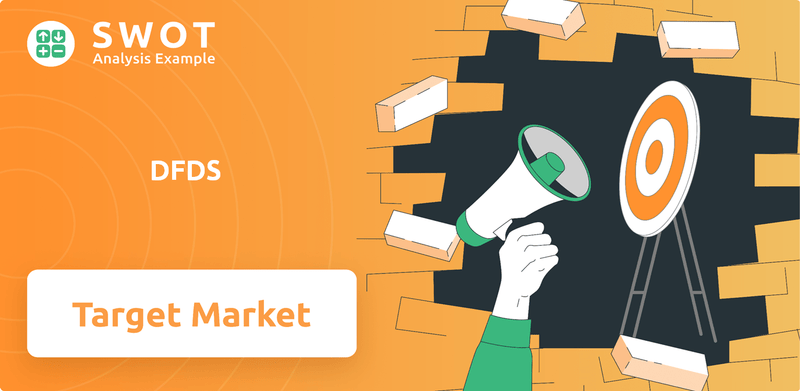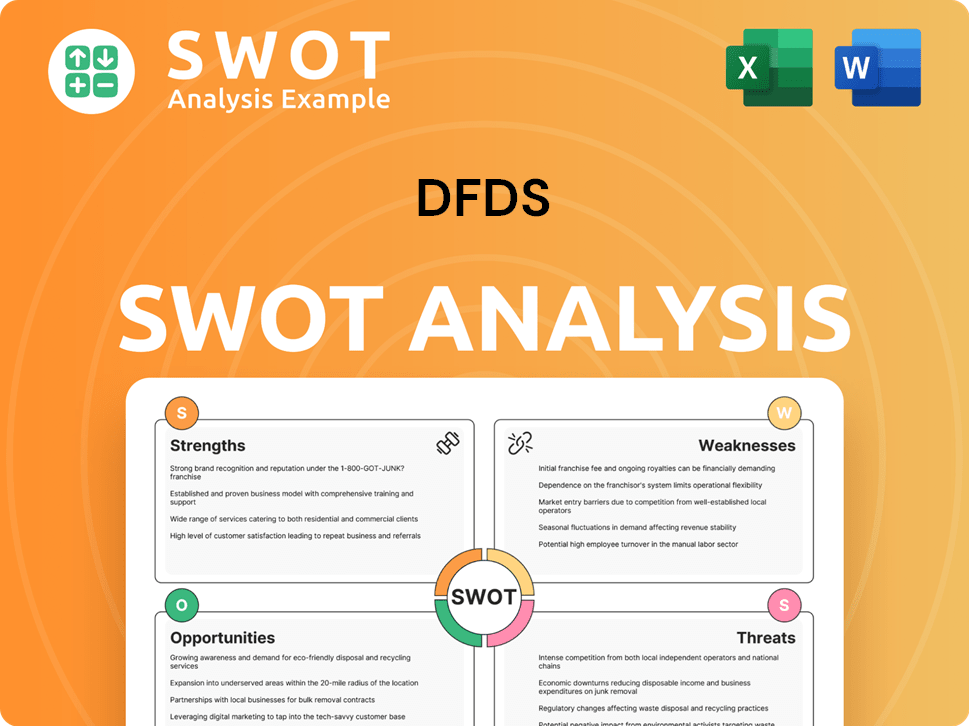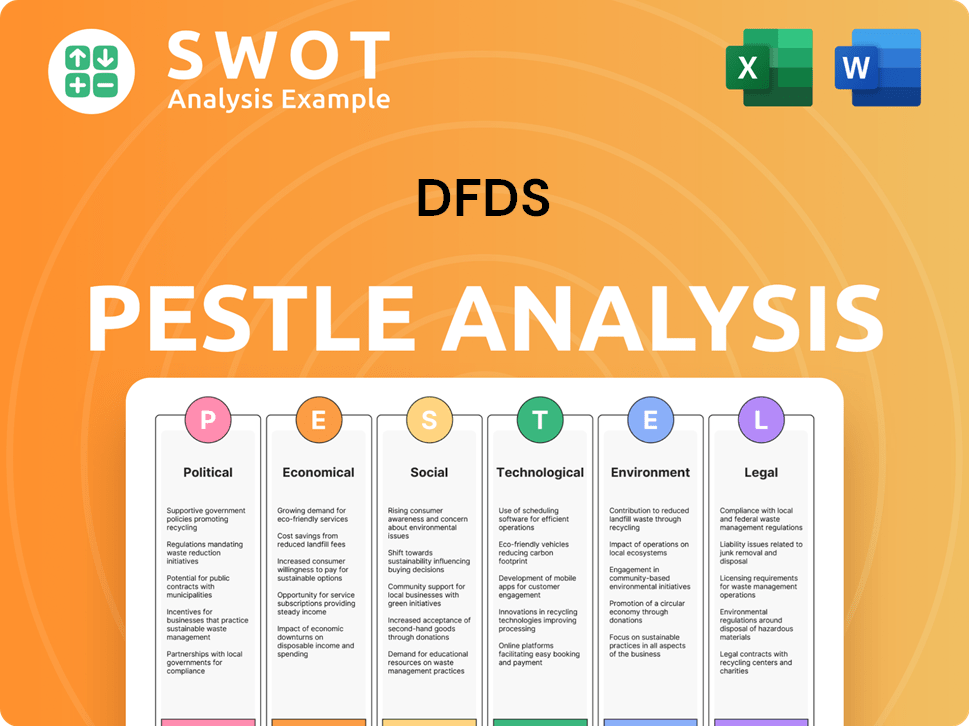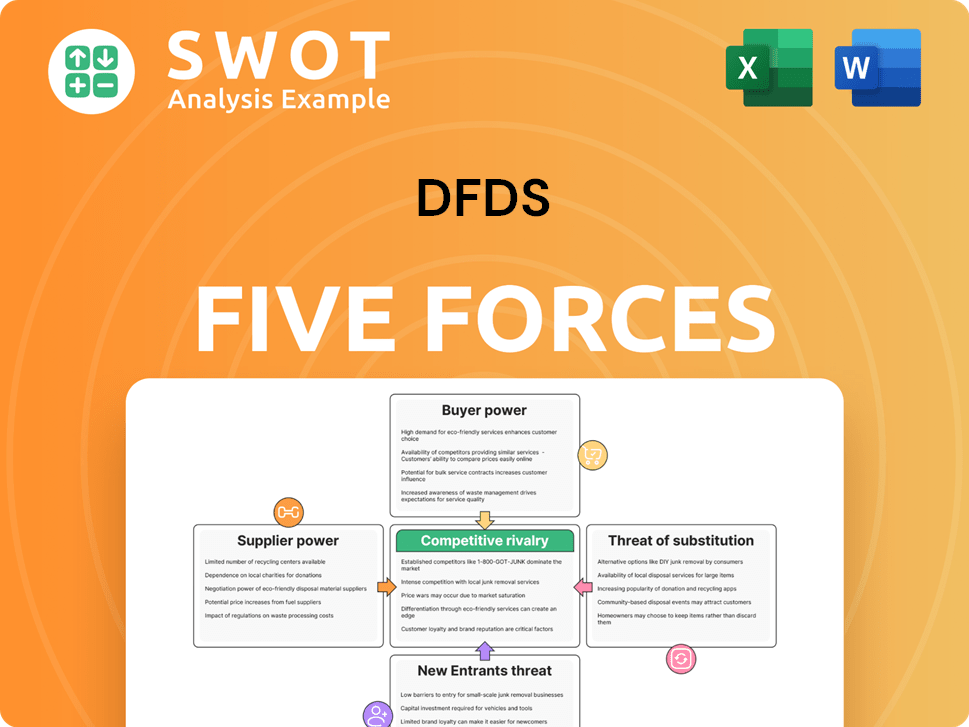DFDS Bundle
Who are DFDS's Customers in 2024 and Beyond?
DFDS, a company with roots in 1866, has dramatically transformed its customer focus. From its origins as a shipping company, DFDS now serves a diverse customer base across Europe and the Mediterranean. This shift is particularly evident with recent acquisitions like FRS Iberia/Maroc and Ekol International Transport. Understanding the DFDS SWOT Analysis is crucial for grasping these changes.

This analysis delves into the evolving customer demographics DFDS serves, exploring the DFDS target market segments driving its growth. We'll examine the DFDS customer profile, considering factors such as DFDS shipping and DFDS logistics needs, geographical distribution, and industry sectors. A detailed DFDS market analysis will provide insights into how DFDS adapts to meet the changing demands of both freight and passenger customers.
Who Are DFDS’s Main Customers?
Understanding the customer base is crucial for any company, and for DFDS, this involves a dual approach. The company caters to both business-to-business (B2B) and business-to-consumer (B2C) segments. This diverse customer profile allows DFDS to capture a broad market share in the shipping and logistics industry. Analyzing the customer demographics and target market of DFDS reveals a strategic focus on both freight and passenger transport.
DFDS's operations are split into Ferry and Logistics divisions, each serving distinct customer groups. This segmentation allows for tailored services and marketing strategies. The company's ability to serve diverse customer segments is a key factor in its market success. This approach is essential for effective DFDS market analysis and strategic planning.
The acquisition of Ekol International Transport in November 2024 significantly expanded DFDS's B2B network, particularly in connecting Türkiye to its existing logistics infrastructure. This strategic move provides end-to-end transport solutions, capitalizing on nearshoring trends. This expansion is a clear example of DFDS adapting to market needs and expanding its customer base.
DFDS's B2B customers include freight forwarders, hauliers, and manufacturers. These businesses rely on DFDS for reliable and efficient transportation across Europe. The company's focus on high-capacity transport solutions caters to the needs of these industries.
For B2C customers, DFDS serves car and foot passengers on its ferry routes. While specific demographic data isn't available, passenger numbers increased by 15.9% to 5.9 million in the last twelve months leading up to April 2025. DFDS aims to enhance the customer experience through improved services.
B2B customers require reliable and high-capacity transport solutions. B2C customers seek comfortable and convenient travel experiences. DFDS addresses these needs through its Ferry and Logistics divisions.
The acquisition of Ekol International Transport is a strategic move to expand DFDS's B2B reach. This expansion allows DFDS to cater to high-growth regions. This is a key aspect of DFDS's market strategy.
DFDS's customer profile is diverse, including freight transport customers and ferry passengers. The company's revenue for 2024 increased by 9.0% to DKK 29.8 billion, with the Ferry division's revenue increasing by DKK 2.4 billion to DKK 17.9 billion. This growth reflects the company's strong market position and effective customer segmentation.
- Freight forwarders and hauliers are key B2B customers.
- Car and foot passengers make up the B2C segment.
- DFDS focuses on providing reliable and efficient services.
- Strategic acquisitions enhance market reach.
For more details on DFDS's business model and revenue streams, you can read this article on Revenue Streams & Business Model of DFDS.
DFDS SWOT Analysis
- Complete SWOT Breakdown
- Fully Customizable
- Editable in Excel & Word
- Professional Formatting
- Investor-Ready Format

What Do DFDS’s Customers Want?
Understanding customer needs and preferences is crucial for the success of any business. For the company, this involves catering to diverse needs across its freight and passenger segments. The company's approach is data-driven, using customer feedback and market trends to shape its offerings and strategic investments.
The company's customer base is primarily driven by the need for reliable, efficient, and capacity-rich transportation and logistics solutions. This focus is evident in its investments in sustainable transport and digital transformation. The company continuously adapts its services to meet evolving customer expectations and maintain a competitive edge in the market.
The company's customer profile includes both B2B freight customers and passenger customers. The company's strategic decisions are heavily influenced by customer needs, as seen in its investments in electric trucks and digital solutions, which are designed to enhance customer satisfaction and support long-term sustainability goals.
Freight customers prioritize seamless movement of goods across an extensive European network. They often require a combination of ferry, road, and rail transport. The acquisition of Ekol International Transport in late 2024 enhanced the company's capabilities in this area.
A growing preference among freight customers is for sustainable transport solutions. The company is investing in electric trucks and setting ambitious decarbonization targets. The goal is for 25% of its fleet to be electric by 2030 and achieve net-zero emissions by 2050.
Passenger customers seek seamless travel experiences, comfort, and onboard amenities. The company invests in improving passenger experience, including upgrading public spaces and enhancing onboard offerings. Digital transformation is also a key focus.
Digital transformation includes improved booking systems and digital customer service solutions. The company tailors its marketing and product features by enhancing onboard connectivity and offering personalized experiences through data analytics.
Common pain points addressed include logistical challenges and disruptions. Prioritizing customer safety and satisfaction ensures minimal interruptions to services. Customer feedback and market trends directly influence product development and strategic investments.
The increasing demand for sustainable options directly influences product development and strategic investments. The company's strategy is to align its offerings with customer needs and preferences to maintain a competitive advantage. Learn more in the Marketing Strategy of DFDS.
The company's approach to meeting customer needs is multifaceted, focusing on reliability, efficiency, and sustainability. This involves strategic investments in both freight and passenger services, ensuring that the company remains competitive and customer-focused. The company's market analysis shows that customer satisfaction levels are directly linked to its ability to provide seamless and sustainable transport solutions.
- Reliability: Ensuring timely and dependable transport services for freight and passengers.
- Efficiency: Streamlining operations to reduce transit times and costs.
- Sustainability: Offering eco-friendly transport options, such as electric trucks.
- Comfort and Amenities: Enhancing the passenger experience through improved facilities and services.
- Digital Solutions: Providing convenient booking systems and digital customer service.
DFDS PESTLE Analysis
- Covers All 6 PESTLE Categories
- No Research Needed – Save Hours of Work
- Built by Experts, Trusted by Consultants
- Instant Download, Ready to Use
- 100% Editable, Fully Customizable

Where does DFDS operate?
The geographical market presence of DFDS is extensive, primarily concentrated in Europe. The company operates a vast network of ferry routes catering to both passengers and freight across key regions. DFDS strategically focuses on Northern Europe, including the Baltic Sea, North Sea, and the English Channel, as well as the Mediterranean, connecting Europe and Turkey.
DFDS maintains a strong market share and brand recognition in these areas, supported by strategic port terminals. Key hubs include Immingham, Rotterdam, Gothenburg, Istanbul, and Trieste. Recent expansions and acquisitions have further solidified its position and broadened its customer base, reflecting its adaptability to evolving market dynamics.
DFDS has strategically expanded its operations through acquisitions and concessions to strengthen its geographical footprint. The acquisition of FRS Iberia/Maroc in 2024 added Strait of Gibraltar ferry routes. Securing a 20-year concession for Jersey ferry services, starting March 2025, further enhances its presence in the English Channel. These moves demonstrate DFDS's commitment to growth and its ability to capitalize on strategic opportunities within the Competitors Landscape of DFDS.
DFDS holds a strong market share in its core operating areas, particularly in Northern Europe and the Mediterranean. Brand recognition is high due to its long-standing presence and reliable service. This strong position allows DFDS to attract a diverse range of customers, from individual passengers to large freight companies, solidifying its customer profile.
DFDS operates through strategic hubs, including port terminals in Immingham, Rotterdam, Gothenburg, Istanbul, and Trieste. These hubs are essential for managing freight and passenger traffic efficiently. The strategic location of these terminals supports DFDS's extensive route network and ensures smooth operations across different geographical areas.
In 2024, the acquisition of FRS Iberia/Maroc added ferry routes in the Strait of Gibraltar. The acquisition of Ekol International Transport significantly expanded its network to include Turkish transport and logistics. Securing a 20-year concession for Jersey ferry services starting March 2025 further solidifies its position. These strategic moves demonstrate DFDS's commitment to growth.
DFDS adapts to regional trade dynamics and customer needs by localizing its offerings and expanding its network. Nearshoring trends drive increased investment and production shifts, particularly in Türkiye and North Africa. DFDS has expanded its intermodal solutions with new train lines in 2025 to Regensburg (Germany), Venlo (Netherlands), and Mosnov (Czechia) to support trade flows.
Freight volumes in the Mediterranean were above 2024 levels, driven by a shift of road volumes to ferry, increased capacity between Tunisia and France, and a new route between Egypt and Italy. This demonstrates DFDS's ability to capitalize on market opportunities and adapt to changing customer needs.
DFDS is expanding its intermodal solutions with new train lines in 2025. These lines will serve Regensburg (Germany), Venlo (Netherlands), and Mosnov (Czechia). This expansion supports trade flows and enhances DFDS's logistics capabilities, catering to the needs of its freight transport customers.
DFDS has divested its Oslo-route in line with its strategic focus. This decision reflects DFDS's commitment to optimizing its route network. It allows the company to concentrate resources on high-growth areas and better serve its target market.
Differences in customer demographics and preferences are evident across regions. The freight sector sees investment shifts to regions like Türkiye and North Africa. DFDS adapts its services to meet specific regional needs, providing tailored solutions for its diverse customer base.
Nearshoring trends are driving increased investment and production shifts. This impacts DFDS's freight services. The company responds by expanding its intermodal solutions and adapting its routes to support these changes, ensuring it meets the evolving needs of its customers.
DFDS has launched new routes and increased capacity. The new route between Egypt and Italy, along with increased capacity between Tunisia and France, demonstrates DFDS's commitment to expanding its services. These moves help DFDS cater to the growing demand in the freight market.
DFDS Business Model Canvas
- Complete 9-Block Business Model Canvas
- Effortlessly Communicate Your Business Strategy
- Investor-Ready BMC Format
- 100% Editable and Customizable
- Clear and Structured Layout

How Does DFDS Win & Keep Customers?
The company employs a multi-faceted approach to customer acquisition and retention. This includes leveraging various marketing channels and strategic initiatives to attract and retain customers. Their focus on organic growth is driven by an expanded product range and bundling of products to meet diverse customer demands. This strategy benefits from its broader geographical network and access to high-growth markets. The company's commitment to customer satisfaction is evident through its digital transformation efforts and focus on building strong customer relationships.
Digital transformation is a core strategy for enhancing the customer experience. This involves improving booking systems, onboard amenities, and digital customer service solutions. Standardization and digitization are key priorities for continually improving customer experience and operational efficiency. In 2024, the company partnered with its customers to achieve positive organic growth, and customer satisfaction improved further. These initiatives are designed to meet the evolving needs of its customer base, ensuring a seamless and positive experience across all touchpoints.
For customer retention, the company emphasizes building strong relationships and providing superior service. Loyalty programs and personalized experiences are crucial. The company aims to develop self-service customer options and provide more transparency and green data to enable flow optimizations for its freight customers. This aligns with the increasing customer demand for sustainable transport solutions, which is a significant factor in securing and retaining large cargo contracts. Actively seeking customer feedback is essential for fostering loyalty and identifying areas for improvement. Understanding the Owners & Shareholders of DFDS can provide insights into the company's strategic direction and customer focus.
The company focuses on organic growth by expanding its product range and bundling services to meet diverse customer needs. This strategy leverages its extensive geographical network and access to high-growth markets. Enhancing digital platforms and improving booking systems are also key to attracting new customers.
The company is enhancing its digital platforms to improve the customer experience. This includes better booking systems, onboard amenities, and digital customer service solutions. Standardization and digitization are strategic priorities to continually enhance customer experience and operational efficiency.
Building strong customer relationships and providing superior service are central to the company's retention efforts. Loyalty programs and personalized experiences are crucial. The company aims to develop self-service options and provide more transparency, especially regarding sustainable transport solutions.
The company highlights its commitment to sustainability, with targets like a 25% reduction in food waste by 2025. This aligns with environmentally conscious customers. Actively seeking customer feedback is crucial for improving services and fostering loyalty.
In 2025, the company is focusing on resolving specific challenges such as adapting Mediterranean ferry operations to a changed competitive environment. Turning around newly acquired logistics businesses to improve financial performance and customer satisfaction is another focus. The company's commitment to sustainability, with targets like a 25% reduction in food waste by 2025, is designed to resonate with environmentally conscious customers.
- Adapting to changing market conditions and competitive pressures.
- Improving financial performance through strategic business decisions.
- Enhancing customer satisfaction through sustainability initiatives and feedback.
DFDS Porter's Five Forces Analysis
- Covers All 5 Competitive Forces in Detail
- Structured for Consultants, Students, and Founders
- 100% Editable in Microsoft Word & Excel
- Instant Digital Download – Use Immediately
- Compatible with Mac & PC – Fully Unlocked

Related Blogs
- What are Mission Vision & Core Values of DFDS Company?
- What is Competitive Landscape of DFDS Company?
- What is Growth Strategy and Future Prospects of DFDS Company?
- How Does DFDS Company Work?
- What is Sales and Marketing Strategy of DFDS Company?
- What is Brief History of DFDS Company?
- Who Owns DFDS Company?
Disclaimer
All information, articles, and product details provided on this website are for general informational and educational purposes only. We do not claim any ownership over, nor do we intend to infringe upon, any trademarks, copyrights, logos, brand names, or other intellectual property mentioned or depicted on this site. Such intellectual property remains the property of its respective owners, and any references here are made solely for identification or informational purposes, without implying any affiliation, endorsement, or partnership.
We make no representations or warranties, express or implied, regarding the accuracy, completeness, or suitability of any content or products presented. Nothing on this website should be construed as legal, tax, investment, financial, medical, or other professional advice. In addition, no part of this site—including articles or product references—constitutes a solicitation, recommendation, endorsement, advertisement, or offer to buy or sell any securities, franchises, or other financial instruments, particularly in jurisdictions where such activity would be unlawful.
All content is of a general nature and may not address the specific circumstances of any individual or entity. It is not a substitute for professional advice or services. Any actions you take based on the information provided here are strictly at your own risk. You accept full responsibility for any decisions or outcomes arising from your use of this website and agree to release us from any liability in connection with your use of, or reliance upon, the content or products found herein.